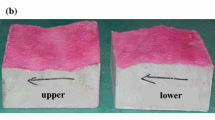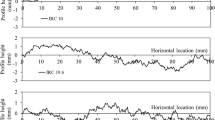Abstract
Joint roughness significantly affects the damage areas and peak shear strength of the rock joint. In this study, theoretical analysis and numerical simulations were carried out, and the results indicated that the resistance angles and heights of asperities quantified the damage range and damage degree, respectively, during the shearing process. Direct shear tests and 3D scanning tests were conducted on sets of mortar joint replicas and sandstone joints. By analyzing the test data, several morphological parameters were proposed to quantify the damage zone of the joint surface. Based on these morphological parameters, a new peak shear strength model, involving the effects of the height and dip angle of the joint surface, was constructed. Finally, the new model and previous classical models were compared. Moreover, the new model was used to predict the shear strength of other joint samples as well. The comparison and prediction results revealed that the new model is suitable for effective prediction of the peak shear strength of joints.


























Similar content being viewed by others
Data availability
All data generated or analyzed during this study are included within the article.
Abbreviations
- θ ∗ :
-
Apparent dip angle (°)
- φ b :
-
Basic friction angle (°)
- τ 0 :
-
Basic friction force (MPa)
- \( \overline{\omega} \) :
-
Characteristic angle (°)
- \( \overline{h} \) :
-
Characteristic height (mm)
- \( {A}_{\omega}^{+} \) :
-
Contact area ratio
- ω cr :
-
Critical resistance angle (°)
- C :
-
Distribution parameter defined by Grasselli (2001)
- ω′ :
-
Effective angle (°)
- h′ :
-
Effective height (mm)
- h :
-
Joint height (mm)
- \( {\theta}_{\mathrm{max}}^{\ast } \) :
-
Maximum apparent dip angle (°)
- A 0 :
-
Maximum contact area ratio
- σ n :
-
Normal stress (MPa)
- i p :
-
Peak dilatancy angle (°)
- τ p :
-
Peak shear strength (MPa)
- A contact :
-
Potential contact area
- ω :
-
Resistance angle (°)
- σ t :
-
Tensile strength (MPa)
- A shear :
-
Total area facing the shear direction
- σ c :
-
Uniaxial compressive strength (MPa)
References
Barton N (1973) Review of a new shear-strength criterion for rock joints. Eng Geol 7:287–332. https://doi.org/10.1016/0013-7952(73)90013-6
Barton N (1976) The shear strength of rock and rock joints. Int J Rock Mech Min Sci Geomech Abstr 13:255–279. https://doi.org/10.1016/0148-9062(76)90003-6
Barton N, Choubey V (1977) The shear strength of rock joints in theory and practice. Rock Mech Rock Eng 10:1–54. https://doi.org/10.1007/BF01261801
Barton N, Bandis S, Bakhtar K (1985) Strength, deformation and conductivity coupling of rock joints. International Journal of Rock Mechanics & Mining Scences & Geomechanics Abstracts 22: 121–140. https://doi.org/10.1016/0148-9062(87)90610-3
Cottrell B (2009) Updates to the GG-shear strength criterion. Dissertation, University of Toronto
Grasselli G (2001) Shear strength of rock joints based on quantified surface description. Dissertation, École Polytechnique Fédérale de Lausanne
Grasselli G, Egger P (2003) Constitutive law for the shear strength of rock joints based on three-dimensional surface parameters. Int J Rock Mech Min Sci 40:25–40. https://doi.org/10.1016/S1365-1609(02)00101-6
Johansson F, Stille H (2014) A conceptual model for the peak shear strength of fresh and unweathered rock joints. Int J Rock Mech Min Sci 69:31–38. https://doi.org/10.1016/j.ijrmms.2014.03.005
Jing L (1990) Numerical modeling of jointed rock masses by distinct element method for two- and three-dimensional problems. Dissertation, Lulea University of Technology
Jang BA, Kim TH, Jang HS (2010) Characterization of the three dimensional roughness of rock joints and proposal of a modified shear strength criterion. J Eng Geol 20:319–327 (in Korean)
Lee YK, Park JW, Song JJ (2014) Model for the shear behavior of rock joints under CNL and CNS conditions. Int J Rock Mech Min Sci 70:252–263. https://doi.org/10.1016/j.ijrmms.2014.05.005
Li Y, Sun S, Tang C (2019) Analytical prediction of the shear behaviour of rock joints with quantified waviness and unevenness through wavelet analysis. Rock Mech Rock Eng 52:3645–3657. https://doi.org/10.1007/s00603-019-01817-5
Liu Q, Tian Y et al (2017) Updates to JRC-JCS model for estimating the peak shear strength of rock joints based on quantified surface description. Eng Geol 228:282–300. https://doi.org/10.1016/j.enggeo.2017.08.020
Maksimović M (1992) New description of the shear strength for rock joints. Rock Mech Rock Eng 25:275–284. https://doi.org/10.1007/BF01041808
Munjiza A (2004) The combined finite-discrete element method. Wiley, Chichester. https://doi.org/10.1002/0470020180
Patton FD (1966) Multiple modes of shear failure in rock. 1st congress of International Society of Rock Mechanics. Lisbon 1:509–513
Schneider HJ (1976) The friction and deformation behaviour of rock joints. Rock Mech Rock Eng 8:169–184. https://doi.org/10.1007/BF01239813
Son BK, Lee YK, Lee CI (2004) Elasto-plastic simulation of a direct shear test on rough rock joints. Int J Rock Mech Min Sci 41:425. https://doi.org/10.1016/j.ijrmms.2003.12.023
Sun FT, She CX, Wang LT et al (2014) Peak shear strength criterion for rock joints based on three-dimensional morphology characteristics. Chinese Journal of Geotechnical Engineering 36:529–536 (in Chinese)
Tatone BS (2009) Quantitative characterization of natural rock discontinuity roughness in-situ and in the laboratory. Dissertation, University of Toronto
Tatone BS, Grasselli G (2009) A method to evaluate the three-dimensional roughness of fracture surfaces in brittle geomaterials. Rev Sci Instrum 80:125110. https://doi.org/10.1063/1.3266964
Tang ZC, Liu QS (2015) Shear strength criterion and shear components of rock joints I: shear strength criterion. Chinese Journal of Geotechnical Engineering 37:292–298. https://doi.org/10.11779/CJGE201502012
Tang ZC, Huang RQ, Liu QS, Wong LNY (2016) Effect of contact state on the shear behavior of artificial rock joint. Bull Eng Geol Environ 75:761–769. https://doi.org/10.1007/s10064-015-0776-z
Tang ZC, Wong LNY (2016) New criterion for evaluating the peak shear strength of rock joints under different contact states. Rock Mech Rock Eng 49:1191–1199. https://doi.org/10.1007/s00603-015-0811-1
Tian Y, Liu Q, Liu D et al (2018) Updates to Grasselli’s peak shear strength model. Rock Mech Rock Eng 51:2115–2133. https://doi.org/10.1007/s00603-018-1469-2
Xia CC, Tang ZC, Xiao WM et al (2014) New peak shear strength criterion of rock joints based on quantified surface description. Rock Mech Rock Eng 47:387–400. https://doi.org/10.1007/s00603-013-0395-6
Yang ZY, Chiang DY (2000) An experimental study on the progressive shear behavior of rock joints with tooth-shaped asperities. Int J Rock Mech Min Sci 37:1247–1259. https://doi.org/10.1016/S1365-1609(00)00055-1
Yang ZY, Taghichian A, Huang GD (2011) On the applicability of self-affinity concept in scale of three-dimensional rock joints. Int J Rock Mech Min Sci 48:1173–1187. https://doi.org/10.1016/j.ijrmms.2011.06.010
Yang J, Rong G, Hou D et al (2016) Experimental study on peak shear strength criterion for rock joints. Rock Mech Rock Eng 49:821–835. https://doi.org/10.1007/s00603-015-0791-1
Yin P, Ma J, Yan C, Huang L (2019) Estimation of the shear strength of fractured Gosford sandstone based on fractal theory and numerical modeling. J Pet Sci Eng 182:106–278. https://doi.org/10.1016/j.petrol.2019.106278
Zhang X, Jiang Q, Chen N et al (2016) Laboratory investigation on shear behavior of rock joints and a new peak shear strength criterion. Rock Mech Rock Eng 49:3495–3512. https://doi.org/10.1007/s00603-016-1012-2
Zhang X (2018) Mesoscopic and macroscopic shear mechanism, morphology srtructure, and shear strength models of rock joints. Dissertation, Wuhan University (in Chinese)
Zhao J (1997a) Joint surface matching and shear strength part a: joint matching coefficient (JMC). Int J Rock Mech Min Sci 34:173–178. https://doi.org/10.1016/S0148-9062(96)00062-9
Zhao J (1997b) Joint surface matching and shear strength part B: JRC-JMC shear strength criterion. Int J Rock Mech Min Sci 34:179–185. https://doi.org/10.1016/S0148-9062(96)00063-0
Zheng B, Qi S (2016) A new index to describe joint roughness coefficient (JRC) under cyclic shear. Eng Geol 212:72–85. https://doi.org/10.1016/j.enggeo.2016.07.017
Code availability
All code generated or used during this study are available from the corresponding author by request.
Funding
This research was funded by the National Natural Science Foundation of China (grant numbers 41907256 and 41807250) and China Postdoctoral Science Foundation under grant no. 2019T120686.
Author information
Authors and Affiliations
Contributions
Conceptualization, Yongchao Tian; validation, Yongchao Tian; investigation, Hao Ma; resources, Hao Ma; writing—original draft preparation, Hao Ma; writing—review and editing, Yucong Pan; funding acquisition, Quansheng Liu. All authors have read and agreed to the published version of the manuscript.
Corresponding author
Ethics declarations
Conflict of interest
The authors declare that they have no conflict of interest.
Rights and permissions
About this article
Cite this article
Ma, H., Tian, Y., Liu, Q. et al. Experimental study on the influence of height and dip angle of asperity on the mechanical properties of rock joints. Bull Eng Geol Environ 80, 443–471 (2021). https://doi.org/10.1007/s10064-020-01904-w
Received:
Accepted:
Published:
Issue Date:
DOI: https://doi.org/10.1007/s10064-020-01904-w




